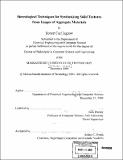Stereological techniques for synthesizing solid textures from images of aggregate materials
Author(s)
Jagnow, Robert Carl, 1976-
DownloadFull printable version (14.66Mb)
Other Contributors
Massachusetts Institute of Technology. Dept. of Electrical Engineering and Computer Science.
Advisor
Julie Dorsey.
Terms of use
Metadata
Show full item recordAbstract
When creating photorealistic digital scenes, textures are commonly used to depict complex variation in surface appearance. For materials that have spatial variation in three dimensions, such as wood or marble, solid textures offer a natural representation. Unlike 2D textures, which can be easily captured with a photograph, it can be difficult to obtain a 3D material volume. This thesis addresses the challenge of extrapolating tileable 3D solid textures from images of aggregate materials, such as concrete, asphalt, terrazzo or granite. The approach introduced here is inspired by and builds on prior work in stereology--the study of 3D properties of a material based on 2D observations. Unlike ad hoc methods for texture synthesis, this approach has rigorous mathematical foundations that allow for reliable, accurate material synthesis with well-defined assumptions. The algorithm is also driven by psychophysical constraints to insure that slices through the synthesized volume have a perceptually similar appearance to the input image. The texture synthesis algorithm uses a variety of techniques to independently solve for the shape, distribution, and color of the embedded particles, as well as the residual noise. To approximate particle shape, I consider four methods-including two algorithms of my own contribution. I compare these methods under a variety of input conditions using automated, perceptually-motivated metrics as well as a carefully controlled psychophysical experiment. In addition to assessing the relative performance of the four algorithms, I also evaluate the reliability of the automated metrics in predicting the results of the user study. To solve for the particle distribution, I apply traditional stereological methods. (cont.) I first illustrate this approach for aggregate materials of spherical particles and then extend the technique to apply to particles of arbitrary shapes. The particle shape and distribution are used in conjunction to create an explicit 3D material volume using simulated annealing. Particle colors are assigned using a stochastic method, and high-frequency noise is replicated with the assistance of existing algorithms. The data representation is suitable for high-fidelity rendering and physical simulation. I demonstrate the effectiveness of the approach with side-by-side comparisons of real materials and their synthetic counterparts derived from the application of these techniques.
Description
Thesis (Ph. D.)--Massachusetts Institute of Technology, Dept. of Electrical Engineering and Computer Science, February 2005. Includes bibliographical references (leaves 121-130).
Date issued
2005Department
Massachusetts Institute of Technology. Department of Electrical Engineering and Computer SciencePublisher
Massachusetts Institute of Technology
Keywords
Electrical Engineering and Computer Science.
